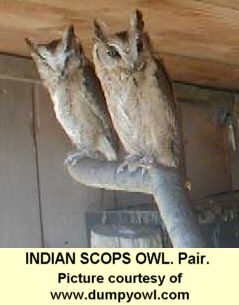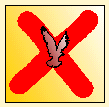
INDIAN SCOPS OWL.
Otus bakkamoena
IDENTIFICATION. Once known as the Collared Scops, Otus bakkamoena has been split into two separate species by avian experts. Collard Scops, Otus lempiji, now refers to the race of Scops found in Eastern Asia and South China. As the name implies the Indian Scops, Otus bakkamoena, is the western race found in India and the Himalayas.
A small owl with pointed ear tufts and dark brown eyes set in a buff coloured facial disc. The body and legs are a mixture of buffs, creams and light browns. The back and tops of the rounded wings are a deep brown with dark brown flecks, not unlike the Little Owl. The sexes can be difficult to distinguish, though the females appear 'dumpier' and more heavily marked.
DISTRIBUTION. India and the Himalayas. Preferred habitat being wooded areas such as forests and fields with cover.
FOOD. Small rodents and birds. Amphibians, reptiles and insects, such as moths, beetles and grasshoppers.
BREEDING. Late March - early April. 3-5 eggs laid in a hole in a tree or rock cavity. Incubation takes 28-29 days with the young fledging at about 4-5 weeks old. The adults continue to feed the young for another 3-4 weeks.
SIZE. 19 - 22 cm (7.5 - 8.5in)
WEIGHT. 120 - 140g. (4 - 4.75oz)
CALL. wo-wo
FALCONRY.
Indian Scops Owls are sometimes used in falconry displays, but their diminutive size should exclude them being flown by all but the most experience falconer. Such things as anklets and jesses can prove difficult for the owl to cope with in flight. If you wish to keep Indian Scops Owls they need a good size aviary, not a parrot cage, and company.
Falconry marks
